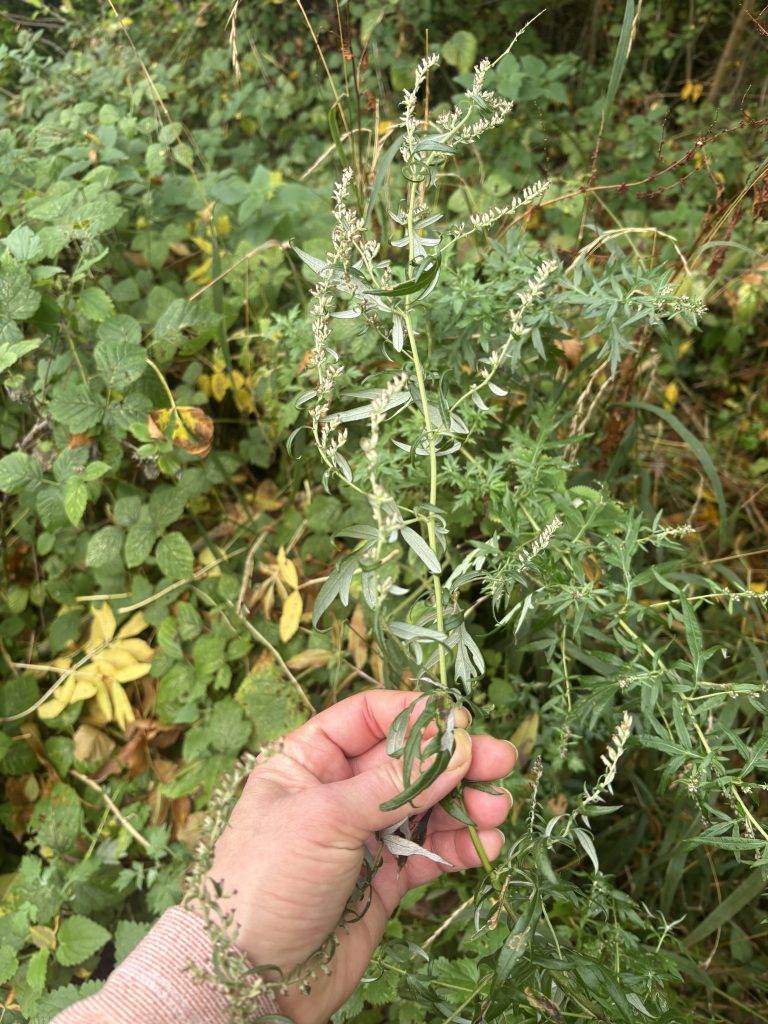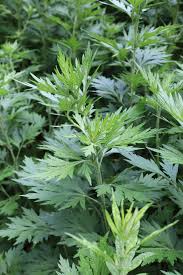Mugwort, Artemesia vulgaris
When running a herb stall at the market, I’m often asked for mugwort, she is a much sought after herb. Though I’m never sure which use she is intended for. There are many applications, let’s look at a few.
Who is mugwort?
But first of all, getting clear on identifying the plant is important. Mugwort grows freely in the wild so is a plant you may well come across, but she can be confused with other similar, and not so similar, plants.
She can grow large, sometimes over six feet. When harvesting for flavouring, such as to put in a vinegar or tea, look for much shorter plants, the taller they get, the more bitter their flavour. We’d typically gather mugwort’s leaves in late summer, for drying, and her roots in autumn.
The key identifier is her leaves, these have deeply divided lobes and a central vein. Notice a smooth top surface, and an undersurface which is downy in texture and silvery white in colour. A colour associated with Artemis, the Greek goddess of the moon, known for her patronage to women in all phases of their lives, and also allied with the dream world – more on these later.
Mugwort is often confused with wormwood, also in the Artemesia family, but with a much stronger aromatic oil (used in the making of absinthe and vermouth, and to add bitterness to ales before hops were widely used). Wormwood has silvering on both top and bottom of the leaves, and much showier flowers.
Your other check should be for smell. Mugwort has a fragrance similar to sage, but this is only emitted when the leaves are bruised. So crush a few leaves and check for the fragrant smell.

Protective Mugwort
Mugwort has long been believed to have magical, protective properties. She features in the ‘Nine Herbs Charm’ from the 10th Century and was used then to repel evil and poisons. The plants of the Artemesia family have been put to protective use in many ways over the years.
Culpepper considered wormwood and vinegar to the be ‘an antidote to the mischief of mushrooms and henbane’ and ‘fresh juice of the herb is a remedy for the taking of too much Opium’.
Through to the 19th Century, a bunch of southernwood (also in the Artemisia family) and rue was put in court to protect against the spread of jail fever from the prisoner. This perhaps explains why mugwort may sometimes be referred to as ‘felon herb’. Mugwort was a popular inclusion in nosegays (posies carried to ward off infections and unpleasant smells) and burning mugwort as an incense creates a positive energy and calm, dispelling negativity in living spaces.
Witches thought wormwood could cure the bite of a seadragon! – there is reference to similar in Culpeper who tells us: combined with vinegar it is effective against the biting of the seafish called Draco marinus or quaviver.
The Women’s Herb
Several of mugwort’s folk names associate her with supporting women, including the title ‘Mother of Herbs’. She is also, variously, ‘the old woman’, maidenwort, mother’s wort and cronewort. Historically, a bunch of mugwort, or a symbol representing this, would be at the door of the local midwife, wise woman or witch healer. Mugwort was relied upon to help many elements of female reproductive health, including promoting menstrual regularity – either provoking or delaying missed periods – and providing comfort during menstrual cramps when drunk as a tea. It was also used externally as a compress to speed up the birth process and help expel the afterbirth. This is perhaps why mugwort has also traditionally been used in fertility rites. It certainly tells us she is a herb to be avoided during pregnancy and should not be given young children. Helpfully mugwort has antiseptic, antibacterial and antifungal properites, as well as being somewhat pain relieving.
Dream Inducing
Mugwort has a tradition of being used to connect us with our dream world. Dried leaves may be put into sleep cushions, slipped under the pillow, or made into a tea to drink before bedtime. It is thought that mugwort has an effect on the pineal gland – also a reason why she has been used at times against fits and epilepsy – which is active in dream state. As a result, mugwort can gently alter perceptions, encouraging wisdom and observation. Whether this goes so far as to enhance psychic visions and spirit communication may depend very much on the individual user. It has not stopped mugwort gaining a reputation for attracting ghosts and aiding astral travel, such as hedge riding. It is certainly one of the herbs witches are said to have used in their flying ointments.
Shakespeare was likely very aware of the association of the Artemesia family with dreaming. Towards the end of his ‘Midsummer Night’s Dream’ Oberon reverses the spell with juice of a herb, referred to as ‘Dian’s bud’ – a name made up by Shakespeare but likely referring to Diana, Artemis’ Roman equivalent, here evoking their reputation as goddesses of hunting and the chase. From this we deduce that Oberon’s juice was likely wormwood or mugwort.
Be as thou wast wont to be;
See as thou wast wont to see:
Dian’s bud o’er Cupids’s flower
Hath such force and blessed power.
Now, my Titania, wake you my sweet queen.
Healthy diet
A bitter herb, mugwort is useful to support appetite, activating the liver to aid digestion and nutrient absorption, but is only needed in small amounts. It is commonly put into soups meats and stews and is a traditional stuffing for roast goose. Geese would be fed mugwort when being fattened, sheep would seek mugwort out of choice, eating both leaves and roots. In times of shortage, mugwort has been used as a substitute for tea. An old saying from Northern England and Scotland emphasises the benefit of mugwort in the diet:
‘If nettles were used in March, and Muggins in May – many a bra’ lass wudna’ turn to t’ clay.’
Healthy skin
Mugwort may be used topically to improve skin health, as a healer, she will help speed up skin’s renewal cycle. Mugwort can be added to salves and balms to help soothe itching and burning. She is used against rashes and bruises, also having some ability to relieve pain. Culpeper suggested using mugwort with Pellitory of the Wall in a poultice to ease outward pain. Mugwort may be added to a bath to alleviate skin conditions, relieve muscle and joint pain and generally invigorate.
Also helpful against frostbite, gout, rheumatism and sciatica, mugwort is traditionally used in China and Japan in the form of moxa. This is made by heating the leaves and then rubbing them to remove the downy fibres. The cotton like fibres are then made into small cones or cylinders ready for use, they are burnt on or near the skin to relieve rheumatic pain caused by cold and damp. The fibres can also be used as a substitute for tinder.
Mugwort is one of the many herbs that have been applied in the hope of preventing baldness, with recommendations to combine ashes of mugwort or southernwood with rosemary and rub on head or beard to help hair growth.
Relieving tiredness
Yet another benefit of mugwort is her ability to relieve fatigue, especially in the weary traveller. Pliny recommended mugwort be put into baths and in the soles of shoes or tied around the necks of wayfarers. Her protective powers helped here too, she was believed to protect the wayfarer from fatigue, sunstroke, wild beasts and evil spirits.
This may help explain the prevalence of mugwort along our roadsides. Romans would deliberately plant the herb along their key routes, making it available for soldiers to put in their sandals on long marches.
Reliance on mugwort for aching feet continued through the centuries. William Coles in ‘The Art of Simpling’ (1656) observed:
‘if a Footman take Mugwort and put into his shoes in the Morning, he may go forty Miles before Noon and not be weary’
It is this application that leads to mugwort’s moniker of ‘the traveller’s herb’.
Moth repellent
The name ‘mugwort’ most likely comes from a corruption of the Anglo-Saxon ‘mucgwrtand’ or ‘midge plant’, a name referencing mugwort’s ability to repel moths and midges. Another reason for her popularity with travellers. She shares this property with her Artemesia sisters, especially southernwood. Popularly dried and laid between clothes in the wardrobe, or sewn into sachets with lavender, or powdered. Thomas Tusser (16th C farmer poet) tells us:
To save against March, to make flea to refrain.
While wormwood hath seed get a bundle or twain.
Where Chamber is swept and wormwood is strown,
No flea for his life dare abide to be known.
John the Baptist
Some know mugwort by the name ‘St John’s Plant’. This is a Christian connection with John the Baptist. He was said to have carried mugwort into the wilderness with him to ward off evil. From this belief arose a tradition of wearing ‘St John’s Girdle’ – a garland of mugwort – on St John’s Day while dancing round a ceremonial fire. The garland would then be tossed into the fire to ensure protection for the following year.

Leave a Reply